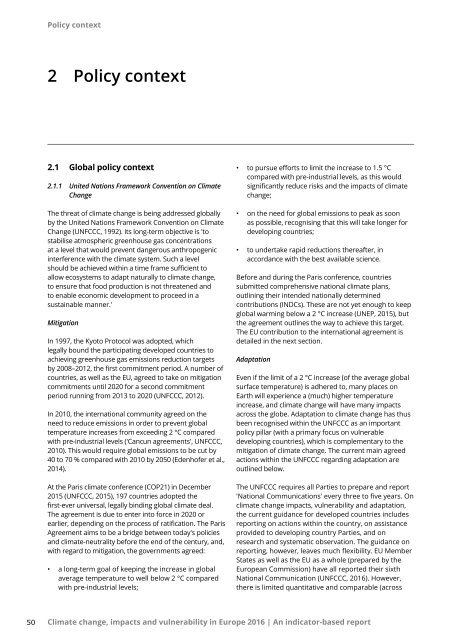Climate change impacts and vulnerability in Europe 2016
document
document
You also want an ePaper? Increase the reach of your titles
YUMPU automatically turns print PDFs into web optimized ePapers that Google loves.
Policy context<br />
2 Policy context<br />
2.1 Global policy context<br />
2.1.1 United Nations Framework Convention on <strong>Climate</strong><br />
Change<br />
The threat of climate <strong>change</strong> is be<strong>in</strong>g addressed globally<br />
by the United Nations Framework Convention on <strong>Climate</strong><br />
Change (UNFCCC, 1992). Its long-term objective is 'to<br />
stabilise atmospheric greenhouse gas concentrations<br />
at a level that would prevent dangerous anthropogenic<br />
<strong>in</strong>terference with the climate system. Such a level<br />
should be achieved with<strong>in</strong> a time frame sufficient to<br />
allow ecosystems to adapt naturally to climate <strong>change</strong>,<br />
to ensure that food production is not threatened <strong>and</strong><br />
to enable economic development to proceed <strong>in</strong> a<br />
susta<strong>in</strong>able manner.'<br />
Mitigation<br />
In 1997, the Kyoto Protocol was adopted, which<br />
legally bound the participat<strong>in</strong>g developed countries to<br />
achiev<strong>in</strong>g greenhouse gas emissions reduction targets<br />
by 2008–2012, the first commitment period. A number of<br />
countries, as well as the EU, agreed to take on mitigation<br />
commitments until 2020 for a second commitment<br />
period runn<strong>in</strong>g from 2013 to 2020 (UNFCCC, 2012).<br />
In 2010, the <strong>in</strong>ternational community agreed on the<br />
need to reduce emissions <strong>in</strong> order to prevent global<br />
temperature <strong>in</strong>creases from exceed<strong>in</strong>g 2 °C compared<br />
with pre-<strong>in</strong>dustrial levels ('Cancun agreements', UNFCCC,<br />
2010). This would require global emissions to be cut by<br />
40 to 70 % compared with 2010 by 2050 (Edenhofer et al.,<br />
2014).<br />
At the Paris climate conference (COP21) <strong>in</strong> December<br />
2015 (UNFCCC, 2015), 197 countries adopted the<br />
first‐ever universal, legally b<strong>in</strong>d<strong>in</strong>g global climate deal.<br />
The agreement is due to enter <strong>in</strong>to force <strong>in</strong> 2020 or<br />
earlier, depend<strong>in</strong>g on the process of ratification. The Paris<br />
Agreement aims to be a bridge between today's policies<br />
<strong>and</strong> climate-neutrality before the end of the century, <strong>and</strong>,<br />
with regard to mitigation, the governments agreed:<br />
• a long-term goal of keep<strong>in</strong>g the <strong>in</strong>crease <strong>in</strong> global<br />
average temperature to well below 2 °C compared<br />
with pre-<strong>in</strong>dustrial levels;<br />
• to pursue efforts to limit the <strong>in</strong>crease to 1.5 °C<br />
compared with pre-<strong>in</strong>dustrial levels, as this would<br />
significantly reduce risks <strong>and</strong> the <strong>impacts</strong> of climate<br />
<strong>change</strong>;<br />
• on the need for global emissions to peak as soon<br />
as possible, recognis<strong>in</strong>g that this will take longer for<br />
develop<strong>in</strong>g countries;<br />
• to undertake rapid reductions thereafter, <strong>in</strong><br />
accordance with the best available science.<br />
Before <strong>and</strong> dur<strong>in</strong>g the Paris conference, countries<br />
submitted comprehensive national climate plans,<br />
outl<strong>in</strong><strong>in</strong>g their <strong>in</strong>tended nationally determ<strong>in</strong>ed<br />
contributions (INDCs). These are not yet enough to keep<br />
global warm<strong>in</strong>g below a 2 °C <strong>in</strong>crease (UNEP, 2015), but<br />
the agreement outl<strong>in</strong>es the way to achieve this target.<br />
The EU contribution to the <strong>in</strong>ternational agreement is<br />
detailed <strong>in</strong> the next section.<br />
Adaptation<br />
Even if the limit of a 2 °C <strong>in</strong>crease (of the average global<br />
surface temperature) is adhered to, many places on<br />
Earth will experience a (much) higher temperature<br />
<strong>in</strong>crease, <strong>and</strong> climate <strong>change</strong> will have many <strong>impacts</strong><br />
across the globe. Adaptation to climate <strong>change</strong> has thus<br />
been recognised with<strong>in</strong> the UNFCCC as an important<br />
policy pillar (with a primary focus on vulnerable<br />
develop<strong>in</strong>g countries), which is complementary to the<br />
mitigation of climate <strong>change</strong>. The current ma<strong>in</strong> agreed<br />
actions with<strong>in</strong> the UNFCCC regard<strong>in</strong>g adaptation are<br />
outl<strong>in</strong>ed below.<br />
The UNFCCC requires all Parties to prepare <strong>and</strong> report<br />
'National Communications' every three to five years. On<br />
climate <strong>change</strong> <strong>impacts</strong>, <strong>vulnerability</strong> <strong>and</strong> adaptation,<br />
the current guidance for developed countries <strong>in</strong>cludes<br />
report<strong>in</strong>g on actions with<strong>in</strong> the country, on assistance<br />
provided to develop<strong>in</strong>g country Parties, <strong>and</strong> on<br />
research <strong>and</strong> systematic observation. The guidance on<br />
report<strong>in</strong>g, however, leaves much flexibility. EU Member<br />
States as well as the EU as a whole (prepared by the<br />
<strong>Europe</strong>an Commission) have all reported their sixth<br />
National Communication (UNFCCC, <strong>2016</strong>). However,<br />
there is limited quantitative <strong>and</strong> comparable (across<br />
50<br />
<strong>Climate</strong> <strong>change</strong>, <strong>impacts</strong> <strong>and</strong> <strong>vulnerability</strong> <strong>in</strong> <strong>Europe</strong> <strong>2016</strong> | An <strong>in</strong>dicator-based report


